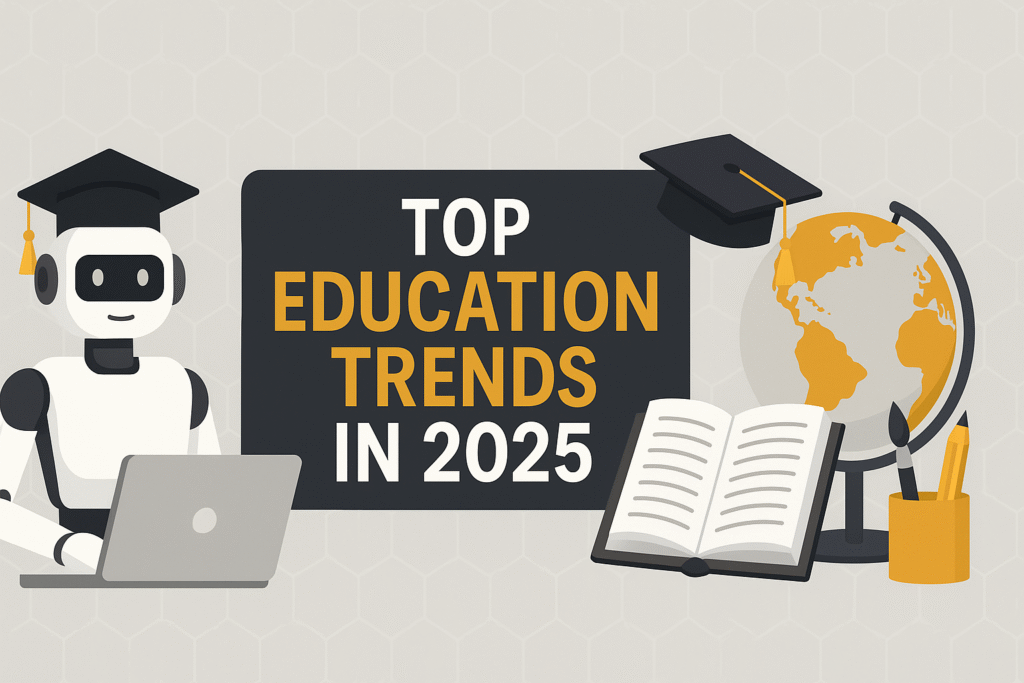Top Education Trends in 2025: AI, Learning Crisis & Curriculum Reform | World News – Education

Top Education Trends in 2025: AI, Learning Crisis & Curriculum Reform
Education in 2025 is at a pivotal moment. From AI entering classrooms to unprecedented learning losses due to climate and pandemic disruptions, the global system is shifting. Let’s explore the key trends shaping education worldwide—and how they affect students, teachers, and policymakers.
1. AI Revolutionizing Learning
Artificial Intelligence has moved from novelty to necessity. Schools worldwide are implementing AI-driven tools that support personalized lessons, automate administrative tasks, and provide real-time feedback. For example, platforms like DreamBox and Carnegie Learning adapt content to each student’s strengths and struggles. Meanwhile, universities are launching AI literacy programs, as seen in U.S. campuses rolling out dedicated versions of ChatGPT to support both faculty and student workflows. Transitioning from traditional lectures, AI is reshaping instruction with built-in support and efficiency.
Balancing Innovation and Integrity
Despite the potential, concerns remain. Some experts warn about academic dishonesty and erosion of critical thinking. In response, certain universities are establishing AI-free zones or requiring students to disclose AI prompts alongside assignments. This hybrid approach aims to preserve intellectual rigor while leveraging technology’s benefits.
2. Learning Poverty and Climate Disruption
A recent UNESCO report found that six in ten primary school children globally lack basic reading or math skills. Learning poverty is rampant from Sub-Saharan Africa to Southeast Asia—and alarming even in developed countries like the U.S., where test scores have declined significantly. In low-income nations, extreme weather—especially heatwaves and floods—forced school closures affecting over 240 million children in 2024 alone. Climate events are interrupting education on a scale rarely seen before.
3. Curriculum Reform & Skill-Based Education
Curriculum is no longer static. Governments from Australia to Cameroon are rewriting frameworks to emphasize competencies like digital literacy, critical thinking, and problem-solving. Schools are shifting from rote memorization to project-based and vocational learning, ensuring students graduate with real-world skills. Meanwhile, entrepreneurship education is growing, helping learners become job creators rather than job seekers.
Integrating Sustainability and Global Awareness
Eco-conscious education is gaining traction globally. Many institutions now embed sustainability across subjects, encouraging hands-on environmental projects and green practices like energy-efficient campuses. UNESCO’s climate-related “Agency in the Anthropocene” standard is being integrated into PISA assessments, aiming to prepare 15-year-olds to distinguish facts from misinformation and act responsibly on environmental issues.
4. EdTech: From VR to Analytics
Immersive learning with AR/VR is redefining classroom experiences. Students can virtually tour historical sites, conduct virtual lab experiments, or interact with 3D models—making abstract concepts more tangible. At the same time, big data and learning analytics help teachers track student progress, identify gaps, and tailor instruction. Combined with blockchain technology, digital credentials (like verified online certificates) are becoming more secure and transparent.
5. Mental Health & Mentorship in Focus
Schools are now treating mental health as a core component of learning. Mindfulness programs, peer support systems, and AI-powered emotional check-ins are becoming standard features. At the same time, mentorship programs are expanding: teacher residencies and leadership tracks offer experienced educators roles beyond classroom teaching, improving retention and creating learning cultures that support both students and staff.
Why These Trends Matter
Each of these developments shows how education is evolving to meet modern challenges. In contrast to traditional models, the new approach is flexible, student‑centered, and globally aware. AI and VR offer tailored experiences; curriculum reform and sustainability education prepare future citizens; and mental health support ensures learners can thrive emotionally as well as academically.
What’s Shaping These Trends?
Several forces are accelerating change: the lingering fallout from COVID‑19, urgent climate disruptions, technological advances, and shifting societal expectations. For instance, AI tools are now deployed to bridge gaps caused by remote learning, while heatwave‑induced school closures reveal how ill-prepared infrastructure sets students back.
What’s on the Horizon?
- Wider AI training for teachers and ethical guidelines for AI use in classrooms.
- Scaling VR labs and cloud-based platforms across global schools.
- Expanding global citizenship education to cultivate climate-aware and socially responsible students.
- Institutionalizing ongoing teacher mentorship and school-based mental health services.
Conclusion
The education sector is undergoing a profound transformation in 2025. With technological innovation, climate resilience, and well‑being at its core, the emerging model promises greater inclusion and relevance. But turning potential into impact requires commitment—from policymakers, educators, parents, and communities alike.
Frequently Asked Questions (FAQs)
Q1. What is learning poverty and why is it worsening?
Learning poverty refers to children attending school but unable to read or solve basic math. It’s worsening due to COVID‑related disruptions, inadequate recovery plans, and climate-related school closures, particularly in vulnerable regions.
Q2. How is AI changing education?
AI is enabling personalized instruction, automating grading, and offering adaptive learning paths. However, concerns about over-reliance and academic integrity have led institutions to implement safeguards and balanced usage policies.
Q3. Why is sustainability education important?
Embedding climate awareness in education builds accountable global citizens and fosters problem-solving skills. It also equips students to tackle environmental challenges with informed action and innovation.